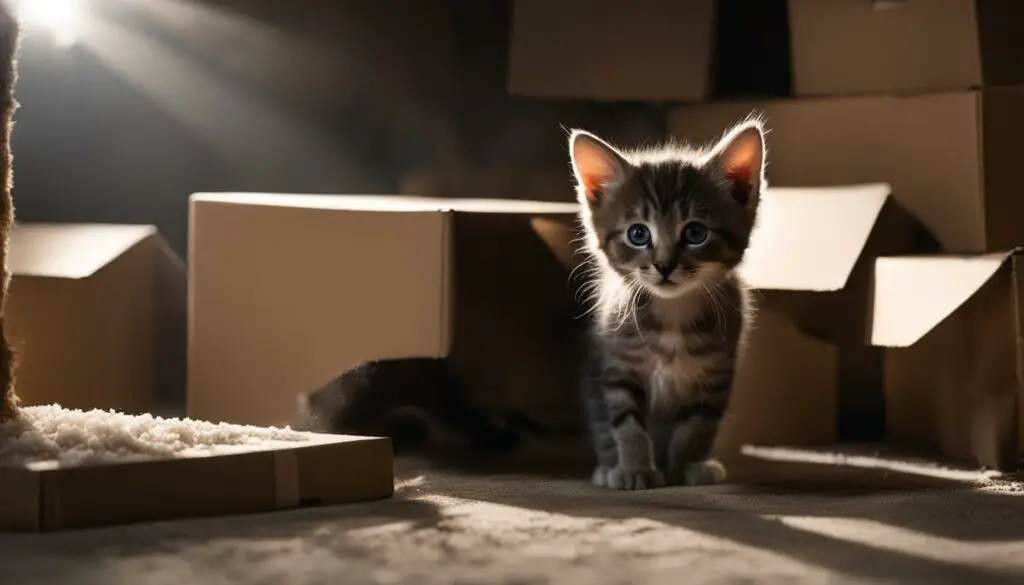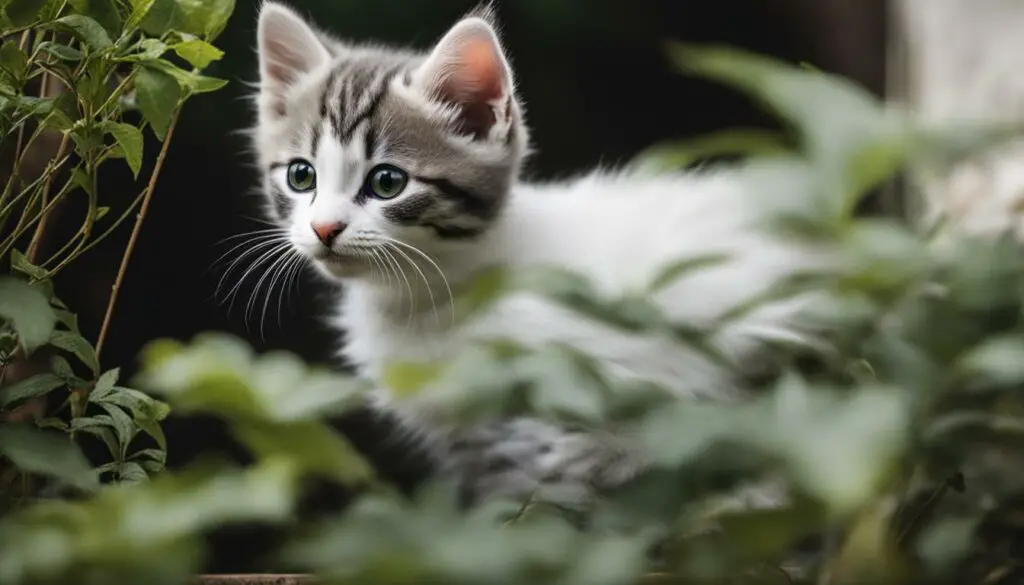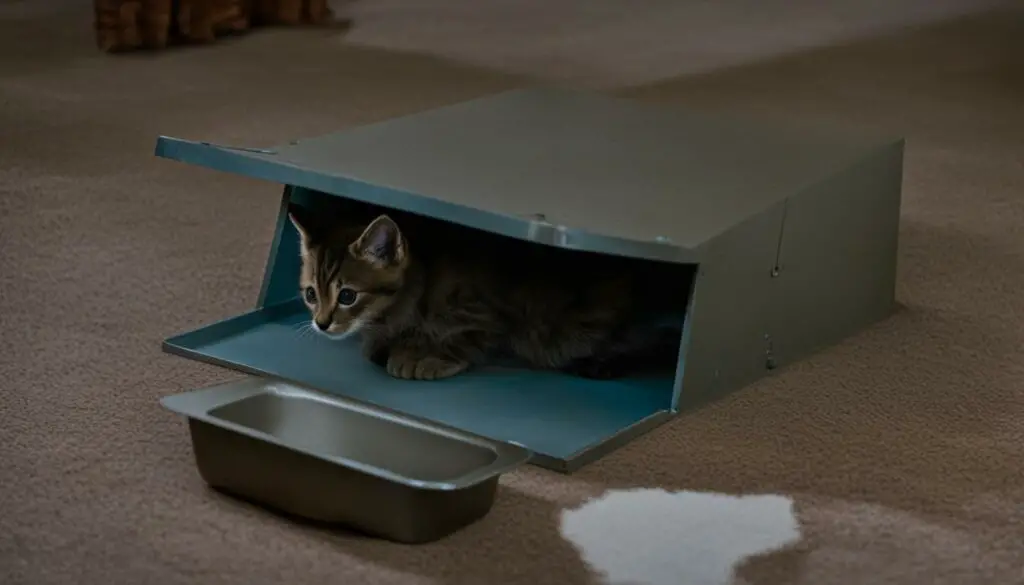Are you searching for ways to lure a kitten out of hiding? I’ve got you covered! Whether you’ve stumbled upon a stray kitten or your own fur baby is playing a game of hide-and-seek, I’ve compiled expert tips and techniques to help you successfully bring that adorable ball of fluff out into the open.
When it comes to luring a kitten out of hiding, it’s important to approach the situation with patience, compassion, and careful planning. Understanding the needs of the kitten, determining the mother cat’s presence, and gauging the kitten’s age are all crucial steps in the process. By following these expert tips and tricks, you’ll be well-equipped to rescue even the most elusive of kittens.
Key Takeaways:
- Before attempting to lure a kitten out of hiding, determine if the mother cat is nearby or if the kitten has been abandoned.
- Estimate the age of the kitten to understand its needs and capabilities.
- Talk to your neighbors and learn about feral cats in the area for valuable information.
- Make a rescue plan and gather necessary materials and vet contacts for a successful rescue.
- Consider using a humane trap or try gently herding the kitten into a confined space for capture.
Determining the Mother Cat’s Presence
Before attempting to lure a kitten out of hiding, it is essential to determine if the mother cat is still around. This is important as it can provide valuable information about the kitten’s situation. Observe the area for more than a few minutes to see if the mother is out hunting for food or if she has truly abandoned the kitten.
Mother cats typically search for food in the mid-afternoon while their kittens are sleeping. If you notice that the kitten is alone in the morning and there is no sign of the mother cat, it may be an indication that the kitten has been abandoned.
Determining the mother cat’s presence is vital because if she is still around, it may be best to leave the kitten where it is and allow the mother to care for it. However, if the mother is not present, it’s time to take action and rescue the kitten.

Table: Signs to determine if the mother cat is present
| Signs of a present mother cat | Signs of an abandoned kitten |
|---|---|
| The mother cat can be spotted hunting for food in the area. | The kitten is alone for extended periods with no sign of the mother. |
| There are other kittens nearby that are being cared for by the mother. | No other kittens are present, and the mother is nowhere to be found. |
| The mother cat appears to be attentive and protective of her kittens. | There is no evidence of the mother cat returning to care for the kitten. |
By carefully observing the behavior of the mother cat and the kitten, it becomes easier to determine if the kitten has been abandoned or if it still has a caretaker. This information will guide the next steps in the rescue process to ensure the best course of action for the kitten’s well-being.
Estimating the Kitten’s Age
When attempting to lure a kitten out of hiding, it is important to estimate its age. This information will help you understand the needs of the kitten and provide appropriate care. There are a few key indicators that can help you determine the age of a kitten.
Physical Development
One way to estimate a kitten’s age is by looking at its physical development. Kittens typically open their eyes around 10 days old. If the kitten’s eyes are still closed, it is likely very young, possibly a newborn. As the kitten grows older, it will become more active and start exploring its surroundings. If the kitten can walk and play without wobbling too much, it is likely at least 4 weeks old.
Weight and Size
Another factor to consider when estimating a kitten’s age is its weight and size. Newborn kittens are very small and typically weigh around 3 to 4 ounces. As they grow, their weight will increase, and they will become more robust. By comparing the kitten’s weight to age charts or consulting with a veterinarian, you can get a better idea of its age.
| Age | Weight |
|---|---|
| Newborn | 3-4 ounces |
| 1 week | 4-7 ounces |
| 2 weeks | 8-14 ounces |
| 4 weeks | 12-20 ounces |
Dental Development
The development of a kitten’s teeth can also provide clues about its age. Newborn kittens have no teeth, but by around 2 weeks old, their baby teeth start to come in. As they reach 3-4 weeks old, their baby teeth will be fully erupted. Around 3-4 months old, their baby teeth will start to be replaced by permanent teeth.
By considering the kitten’s physical development, weight, size, and dental development, you can make a reasonable estimation of its age. This information will be helpful in providing the appropriate care and nutrition for the kitten.

Talking to Neighbors and Learning About Feral Cats
When it comes to luring a kitten out of hiding, talking to your neighbors can provide valuable insights and help in your rescue efforts. Engaging in conversation and gathering information about feral cats in the area can give you a better understanding of the overall situation. By sharing your observations and discussing any sightings of stray or feral kittens, you can gather helpful information that may contribute to a successful rescue.
In addition to talking to your neighbors, consider posting flyers in your community to raise awareness about the kitten. Include a description and a contact number, so people can reach out if they have any relevant information. Utilize social media platforms to share photos and provide updates on your rescue efforts. You never know who may have seen the kitten or have knowledge of its whereabouts.
It’s important to educate yourself about feral cats and their behavior. Understanding their instincts and tendencies can help you approach the stray kitten in a way that is less intimidating and more effective. Feral kittens may display skittish behaviors due to their lack of exposure to humans, making it crucial to approach the situation with patience and compassion. By contacting your local veterinary clinic or animal shelter, you can gain valuable information about the presence of feral cats in the area and receive guidance on how to proceed with the rescue.

Gathering Information from Neighbors
Talking to your neighbors can provide valuable information that can aid in the rescue of a stray or feral kitten. By engaging in conversations, you can gather insights into the kitten’s behavior, potential hiding spots, and whether there are other feral cats in the area. Share your intention to rescue the kitten and ask if anyone has seen it or has any knowledge about its situation. This collaborative effort can increase your chances of locating and rescuing the kitten successfully.
Posting Flyers and Utilizing Social Media
Posting flyers in your community is an effective way to spread the word about the stray kitten and gather information. Include a clear description of the kitten, as well as your contact information, so that individuals who have seen or know about the kitten can reach out to you. Additionally, harness the power of social media by sharing photos and updates about the rescue efforts. This can reach a wider audience and increase the chances of receiving relevant information that can lead to the successful rescue of the kitten.
Understanding Feral Cats and Their Behavior
Feral cats have distinct behavior patterns due to their lack of human socialization. By understanding these behaviors, you can approach the stray kitten in a way that is less threatening and more likely to gain its trust. Feral kittens may be skittish and fearful of humans, requiring patience and a gentle approach. By seeking guidance from your local veterinary clinic or animal shelter, you can gain valuable insights into feral cat behavior and receive tailored advice on how to handle the rescue process.
Making a Rescue Plan
When it comes to rescuing a hidden kitten, having a well-thought-out plan is crucial for success. By preparing in advance, you can ensure a smooth and efficient rescue process. Here are some key steps to consider:
- Time Commitment: Rescuing a kitten takes time and dedication. Assess your schedule and determine how much time you can commit to the rescue process. It may involve several days or even weeks of effort.
- Materials: Gather the necessary materials for the rescue. This may include a humane trap, carrier or box with a lid, soft towels or blankets, gloves for handling, and food to lure the kitten. Having these items ready in advance will save you time and stress during the rescue.
- Vet Contacts: Research and establish contact with a veterinarian who can provide medical care for the rescued kitten. Make sure you know their location and contact information so you can seek immediate help if needed.
“Rescuing a hidden kitten requires careful planning and preparation. By considering the time commitment, gathering the necessary materials, and having vet contacts ready, you can increase the chances of a successful rescue.” – Cat Rescuer
By making a rescue plan and being prepared, you can approach the rescue with confidence and increase the likelihood of a positive outcome for both you and the kitten.
| Key Steps | Benefits |
|---|---|
| Assess time commitment | Ensures you can dedicate enough time to the rescue process |
| Gather necessary materials | Allows for a smooth and efficient rescue |
| Establish vet contacts | Provides immediate access to medical care when needed |
Using a Humane Trap
When it comes to luring a kitten out of hiding, using a humane trap can be an effective and safe method. Whether you choose to purchase a trap or make one yourself, it is important to ensure that it is designed to prevent harm to the kitten. A humane trap typically consists of a cage-like structure with a trigger mechanism that can be activated to capture the kitten securely.

To entice the kitten into the trap, you can use food as bait. Canned fish, such as tuna or sardines, can be particularly enticing for kittens. Place a small amount of the food near the entrance of the trap and gradually move it closer to the trigger mechanism over time. This allows the kitten to become more comfortable with entering the trap to reach the food, increasing the chances of a successful capture.
Patience is key when using a humane trap. It may take some time for the kitten to feel comfortable enough to enter the trap. It is important to consistently feed the kitten near the trap to create positive associations. Additionally, avoid trapping the kitten during extreme weather conditions or when it is likely to encounter danger outside of its hiding spot.
Source Links
- https://smittenwithkittens.net/cat-fact-files/ten-things-you-can-do-to-help-a-stray-kitten
- https://www.dailypaws.com/cats-kittens/cat-safety-tips/how-to-catch-a-cat
- https://www.wikihow.com/Catch-a-Stray-Kitten








